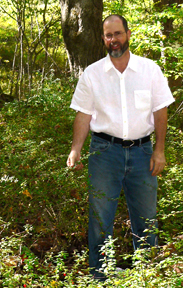Jeffrey S. Ward

Department of Environmental Science and Forestry
The Connecticut Agricultural Experiment Station
123 Huntington Street
New Haven, CT 06511
Voice: (203) 974-8495 Fax: (203) 974-8502
E-mail: Jeffrey.Ward@ct.gov
Expertise:
Dr. Ward has expertise in identification and life histories of native trees and shrubs, forest management, invasive shrub control, plantation establishment, and forest nursery operation. He is knowledgeable about the natural history of Connecticut, landscape maintenance, and methods of reducing deer browse damage.
Education:
Ph.D. Purdue University (Forest Ecology) 1987
M.S. The Ohio State University (Silviculture) 1983
Peace Corps Training (Forestry Extension) 1979
B.Sc. The Ohio State University (Natural Resources) 1979
Station Career:
Chief Scientist Emeritus 2022-present
Chief Scientist 2005-2022
Agricultural Scientist 2003-2004
Associate Scientist 1998-2002
Assistant Scientist 1987-1997
Past Research:
Research conducted during M.S. program focused how regeneration was influenced by alternative management techniques. During his Ph.D. program, Dr. Ward examined the community structure of an old-growth upland oak forest. Earlier research at the station included evaluation of browse protection and weed control in forest plantations, an examination of fuelwood thinning on regeneration and volume growth of residual trees, and the influence of urban development on inland wetland communities.
Current Research:
Enhancing oak regeneration (with Cornell University, South Central Connecticut Regional Water Authority; Metropolitan District Commission; Massachusetts DCR, Division of Water Supply Protection, McLean Wildlife Refuge) – This study was begun after the 2020 growing season to examine the efficacy of using post-harvest logging debris to create slash walls that exclude deer and moose browsing after forest regeneration harvests. Regeneration has been followed both outside and inside the five slash wall enclosing 101 acres.
Increasing persistence of white oak (with South Central Regional Water Authority; Massachusetts DCR, Division of Water Supply Protection) – The initial study was begun in 2021 with three study areas to determine if crop tree release of white oak saplings increases the proportion that will be present in a mature forest. Two additional study area with enhanced release were established prior to the 2024 growing season.
Natural changes in unmanaged hardwood forests (with CT-DEEP Forestry; Great Mountain Forest; and the White Memorial Forest) – This study was begun in 1926 and has monitored the influence of disturbance and defoliation on natural succession in eight unmanaged Connecticut forests by monitoring the growth and survival of over 46,000 trees. Plots have been surveyed at 10-year intervals and will be re-measured in 2017.
Selected recent publications available from the author, Jeffrey.Ward@ct.gov
- Ward, J.S., E.B. Ward, and J.P. Barsky. 2025. Excluding deer browse increases stump sprouting successand height growth following regeneration harvests. Canadian Journal of Forest Research. 55(1):1-12. doi:10.1139/cjfr-2024-0318.
- Nieves, J.M., J.S. Ward, A.A. Royo, M.E. McDill, J.K. Kreye, and K.M. Steiner. 2022. Stand and site characteristics affect the probability of stump sprouting in some eastern North American hardwoods. Forest Ecology and Management. 511: 120136. doi.org/10.1016/j.foreco.2022.120136.
- Ward, J.S., C.C. Jones, and J.P. Barsky. 2022. Multi-year defoliations in southern New England. Canadian Journal of Forest Research. 52:269-279 doi:10.1139/cjfr-2021-0174
- Fielding, E., E. Hansen, C. Folsom-O’Keefe, K. Elkins, J. Ward, J. Milne, S. Treyger, M. Burger. 2021. Managing forests for trees and birds in Connecticut: A guide to habitat assessments and silvicultural practices. Audubon Connecticut, Sharon CT. 22p. https://ct.audubon.org/guide-to-managing-forests-in-ct.
- Ward, J.S., and S.C. Williams. 2020. Influence of deer hunting and residual stand structure on tree regeneration in deciduous forests. Wildlife Society Bulletin 1-12; DOI:10.1002/wsb.1120.
- Ward, J.S. and J. Wikle. 2019. Increased tree growth maintains mature oak stand volume growth after thinning and crop tree management. Forest Science 65(6): 784-795. doi: 10.1093/forsci/fxz042
- Ward, J.S. 2019. Rehabilitation of poorly stocked stands using a microstand approach. P. 145-154 In Proceedings of the Oak Symposium: Sustaining Oak Forests in the 21st Century through Science-based Management, S. Clark and C. Schweitzer (eds.). USDA Forest Service e-General Technical Report SRS-237. 192p.
- Ward, J.S. 2019. Assessing effectiveness of oak regeneration prescriptions. New England Society of American Foresters News Quarterly. 80 (1): 4-5.
- Ward, J.S., and S.C. Williams. 2018. Effect of tree diameter, canopy position, age, and browsing on stump sprouting in southern New England. Forest Science 64(4): 452-460. doi: 10.1093/forsci/fxx023
- Ward, J.S., S.C. Williams, and M.A. Linske. 2018. Influence of invasive shrubs and deer browsing on regeneration in temperate deciduous forests. Canadian Journal of Forest Research 48(1): 58-67. doi: 10.1139/cjfr-2017-0208
- Linske, M.A., S.C. Williams, J.S. Ward, and K.C. Stafford III. 2018. Indirect effects of Berberis thunbergii infestations on Peromyscus leucopus exposure to Borrelia burgdorferi. Environmental Entomology 47(11): 795-802. doi.org/10.1093/ee/nvy079.
- Williams, S.C., M.A. Linske, M.A., and J.S. Ward. 2017. Long-term effects of Berberis thunbergii (Ranunculales: Berberidaceae) management on Ixodes scapularis (Acari: Ixodidae) abundance and Borrelia burgdorferi (Spirochaetales: Spirochaetaceae) prevalence in Connecticut, USA. Environmental Entomology. 46(6): 1329-1338. doi: 10.1093/ee/nvx146
- Ward, J.S. 2017. Twenty-five year response of non-crop trees to partial release during precommercial crop tree management. Forest Ecology and Management 387: 12-18. http://dx.doi.org/10.1016/j.foreco.2016.05.036
- Leak, W.B., M. Yamasaki, J.S. Ward, J. Desmarais, and K. Bennett. 2017. Ecology and management of northern red oak in New England. University of New Hampshire Cooperative Extension, Durham, NH. 50p. https://extension.unh.edu/resources/files/Resource006927_Rep9991.pdf
- Ward, J.S., T.E. Worthley, T.J. Degnan, and J.P. Barsky. 2017. STORMWISE: Integrating arboriculture and silviculture to create storm resilient roadside forests P. 119-132 In Proceedings 20th Central Hardwood Conference, Kabrick, J.M. et al. (eds.). USDA Forest Service General Technical Report NRS-P-167. 313 p.
- Ward, J.S., S.C. Williams, M.A. Linske. 2016. Independent effects of invasive shrubs and deer herbivory on plant community dynamics. Forests 8(2) 1-18. doi:10.3390/f8010002
- Ward, J.S. 2015. Improving competitive status of oak regeneration using stand management and prescribed fires. Journal of Sustainable Forestry 34: 105-124.

